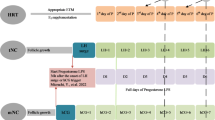Abstract
The increasing use of frozen–thawed embryo transfer (FET) cycles has magnified the focus on endometrial preparation protocols in assisted reproduction. Emerging evidence suggests that natural cycle (NC) FETs are associated with improved outcomes, and that providers should consider increasing the utilization of NC FET at the expense of the currently favored artificial cycle (AC) FET as primary method for endometrial preparation.
Similar content being viewed by others
References
Celada P, Bosch E. Freeze-all, for whom, when, and how. Ups J Med Sci. 2020;125(2):104–11.
Chen ZJ, Legro RS. Fresh versus frozen embryos in polycystic ovary syndrome. N Engl J Med. 2016;375(20):e42.
Healy MW, Patounakis G, Connell MT, Devine K, DeCherney AH, Levy MJ, et al. Does a frozen embryo transfer ameliorate the effect of elevated progesterone seen in fresh transfer cycles? Fertil Steril. 2016;105(1):93–9 e1.
Quaas AM, Hansen KR. Time to “cool off”? Examining indications for “elective deferred frozen embryo transfer”. J Assist Reprod Genet. 2016;33(12):1551–2.
Maheshwari A, Pandey S, Amalraj Raja E, Shetty A, Hamilton M, Bhattacharya S. Is frozen embryo transfer better for mothers and babies? Can cumulative meta-analysis provide a definitive answer? Hum Reprod Update. 2018;24(1):35–58.
Wu H, et al. Endometrial preparation for frozen-thawed embryo transfer cycles: a systematic review and network meta-analysis. J Assist Reprod Genet. 2021. https://doi.org/10.1007/s10815-021-02125.
Sunderam S, Kissin DM, Zhang Y, Jewett A, Boulet SL, Warner L, et al. Assisted Reproductive Technology Surveillance - United States, 2017. MMWR Surveill Summ. 2020;69(9):1–20.
Wyns C, et al. ART in Europe, 2016: results generated from European registries by ESHRE. Hum Reprod Open. 2020;2020(3).
Hipp H, Crawford S, Kawwass JF, Boulet SL, Grainger DA, Kissin DM, et al. National trends and outcomes of autologous in vitro fertilization cycles among women ages 40 years and older. J Assist Reprod Genet. 2017;34(7):885–94.
Gaume R, et al. Large for gestational age following frozen embryo transfer: an evaluation of the possible causes for this relationship. F&S Rev. 2020.
Alur-Gupta S, Hopeman M, Berger DS, Gracia C, Barnhart KT, Coutifaris C, et al. Impact of method of endometrial preparation for frozen blastocyst transfer on pregnancy outcome: a retrospective cohort study. Fertil Steril. 2018;110(4):680–6.
Ginstrom Ernstad E, et al. Neonatal and maternal outcome after frozen embryo transfer: increased risks in programmed cycles. Am J Obstet Gynecol. 2019;221(2):126 e1–126 e18.
Makhijani R, Bartels C, Godiwala P, Bartolucci A, Nulsen J, Grow D, et al. Maternal and perinatal outcomes in programmed versus natural vitrified-warmed blastocyst transfer cycles. Reprod Biomed Online. 2020;41(2):300–8.
Zhang J, Wei M, Bian X, Wu L, Zhang S, Mao X, et al. Letrozole-induced frozen embryo transfer cycles are associated with a lower risk of hypertensive disorders of pregnancy among women with polycystic ovary syndrome. Am J Obstet Gynecol. 2021.
Singh B, Reschke L, Segars J, Baker VL. Frozen-thawed embryo transfer: the potential importance of the corpus luteum in preventing obstetrical complications. Fertil Steril. 2020;113(2):252–7.
Author information
Authors and Affiliations
Corresponding author
Additional information
Publisher’s note
Springer Nature remains neutral with regard to jurisdictional claims in published maps and institutional affiliations.
Rights and permissions
About this article
Cite this article
Pier, B.D., Havemann, L.M., Quaas, A.M. et al. Frozen-thawed embryo transfers: time to adopt a more “natural” approach?. J Assist Reprod Genet 38, 1909–1911 (2021). https://doi.org/10.1007/s10815-021-02151-y
Received:
Accepted:
Published:
Issue Date:
DOI: https://doi.org/10.1007/s10815-021-02151-y




